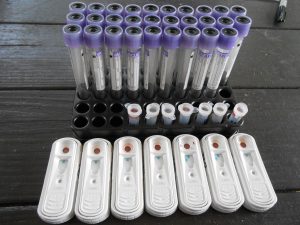Module 2: Preventive health care and health surveillance
Disease Screening: FeLV and FIV
After vaccination and parasite treatment at intake, shelter animals still require regular care. Protocols for routine wellness care are important for ensuring that pets remain healthy during their shelter stay. Wellness care not only includes continuing vaccination and parasite treatment at the recommended intervals, but also includes screening for important infections such as FeLV/FIV in cats and heartworm in dogs.
A recent study of 62,000 cats in veterinary clinics and shelters in North America showed that the prevalence of FeLV (~3%) and FIV (~3%) was about the same for shelter cats as for owned pet cats. While 3% prevalence is low, if about 3 million cats enter shelters each year, then about 90,000 infected cats are likely to pass through shelters each year. Therefore, all cats entering shelters should be considered potentially infected, regardless of the environment from which they originated.
Review the 2020 AAFP Retrovirus Guidelines for shelter cats.
These Guidelines recommend testing of all cats for FeLV and FIV since identification and segregation of infected cats is the most important measure for control of retrovirus transmission. In addition, all cats should be tested for FeLV prior to vaccination. Commercially available point-of-care (POC) tests are routinely used to screen cats for infection based on detection of viral antigen for FeLV and antiviral antibody for FIV in whole blood or serum. As shown in the following table, one study that assessed the diagnostic accuracy of four commonly used POC tests found differences in test performance for FeLV but not FIV.
Diagnostic Performance of FeLV and FIV Point of Care Tests*
*Data from Levy et al. Journal of Veterinary Internal Medicine 2017; 31:521-526.
| FeLV Antigen | FIV Antibody | |||
|---|---|---|---|---|
| Sensitivity | Specificity | Sensitivity | Specificity | |
| SNAP (Idexx) | 100% | 100% | 98% | 99% |
| Witness (Zoetis) | 89% | 96% | 95% | 100% |
| Anigen (Bionote) | 92% | 96% | 97% | 99% |
| VetScan (Abaxis) | 86% | 86% | 92% | 99% |

The best practice is to select a FeLV/FIV POC test with higher sensitivity and specificity for screening cats in shelters. The shelter can adopt a “one and done” strategy where the POC test is used to determine the initial status of the cat while in shelter care. When performed with a POC screening test with higher sensitivity and specificity, this “one and done” protocol will identify most infected cats. Sensitivity and specificity are very important factors to consider when choosing what screening test to use. Tests with lower sensitivity may miss infected cats (false negatives) that would not be segregated and remain an infectious risk to other cats. Tests with lower specificity may misidentify uninfected cats as infected (false positives), leading to possible euthanasia.
The 2020 Retroviral Management Guidelines (page 12) do not recommend testing for FIV antibody in kittens before 6 months of age because the POC tests cannot differentiate between FIV antibodies due to infection from those that are acquired by ingestion of colostrum from an infected queen. Kittens born to FIV-infected queens can test false positive in the FIV POC tests until the maternal antibody has decayed, typically between 3 to 5 months of age. This age exception for FIV testing does not apply to FeLV because the FeLV POC tests detect viral antigen circulating in the blood of infected kittens. Therefore, FeLV testing can be done at any age. FeLV POC tests perform better with whole blood than serum.
Key Takeaways for FeLV/FIV Testing
- Prevalence of FeLV (3%) and FIV (3%) in shelter cats is similar to that in owned pet cats
- FeLV infection occurs through transmission from mother to kittens and by close contact between cats
- FIV infection occurs mainly through bite wounds inflicted by fighting
- High risk cats for retroviral infection include those that are sick, have bite wounds, or live in close association with infected cats
- Most important measure for controlling FeLV and FIV transmission is testing all cats to identify and segregate infected cats
- POC tests are routinely used to screen cats for FeLV or FIV infection
- Select a FeLV/FIV POC test with higher sensitivity and specificity to screen cats in shelters as these will correctly identify most infected cats
- Do not test kittens <6 months old with FIV POC tests since these cannot differentiate antibody from natural infection vs. maternal antibody acquired by nursing infected queens. Kittens born to infected queens may test false positive before 6 months old.
- Kittens can be tested at any age with FeLV POC tests since these detect viral antigen produced by infected cells in circulation
- FeLV POC tests perform better with whole blood instead of serum

